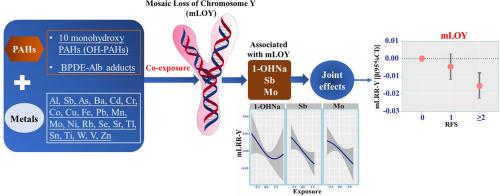Journal of Hazardous Materials ( IF 13.6 ) Pub Date : 2021-02-24 , DOI: 10.1016/j.jhazmat.2021.125519 Yansen Bai , Xin Guan , Wei Wei , Yue Feng , Hua Meng , Guyanan Li , Hang Li , Mengying Li , Chenming Wang , Ming Fu , Jiali Jie , Xiaomin Zhang , Meian He , Huan Guo

|
Mosaic loss of chromosome Y (mLOY) is an indicator of genome instability, but the environmental stressors of mLOY remained largely unknown. In this study, we detected the internal exposure levels of 11 polycyclic aromatic hydrocarbon (PAH) metabolites and 22 metals among 888 coke-oven workers, and calculated their blood mLOY based on genome-wide SNP genotyping data and presented as median log R ratio (mLRR-Y). The generalized linear model (GLM), LASSO, and Bayesian kernel machine regression (BKMR), were used to select mLOY-relevant chemicals. The results of these models consistently suggested the negative dose-response relationships of urinary 1-hydroxynaphthalene (1-OHNa), antimony (Sb), and molybdenum (Mo) with mLRR-Y. There were no pairwise interactions between these three chemicals (Pinteraction > 0.05), but subjects with high exposure to ≥ 2 kinds of these chemicals showed reducing mLRR-Y [β(95%CI) = − 0.015(− 0.023, − 0.008)], increasing oxidative DNA damage (marked by 8-hydroxydeoxyguanosine) [β(95%CI) = 0.625(0.454, 0.796)] and chromosome damage (marked by micronucleus frequency in lymphocytes) [frequency ratio (FR) and 95%CI = 1.146(1.047, 1.225)] than those with low exposure to all these chemicals. The combined effects of 1-OHNa, Sb, and Mo on elevating DNA damage may partly explain their joint effects on increased blood mLOY. These results provided a new insight into environmental hazards co-exposure on chromosome-Y deletions.
中文翻译:

多环芳烃与多种金属共同暴露对外周血Y染色体镶嵌损失的影响
Y染色体的镶嵌损失(mLOY)是基因组不稳定的指标,但是mLOY的环境压力因素仍然未知。在这项研究中,我们检测了888名焦炉工作人员中11种多环芳烃(PAH)代谢产物和22种金属的内部暴露水平,并根据全基因组SNP基因分型数据计算了他们的血液mLOY,并表示为中位数log R比( mLRR-Y)。使用广义线性模型(GLM),LASSO和贝叶斯核仁机器回归(BKMR)来选择与mLOY相关的化学品。这些模型的结果一致表明,尿1-羟基萘(1-OHNa),锑(Sb)和钼(Mo)与mLRR-Y呈负剂量反应关系。这三种化学物质之间没有成对相互作用(P相互作用> 0.05),但是高暴露于≥2种这类化学物质的受试者显示出降低的mLRR-Y [β(95%CI)=-0.015(-0.023,-0.008)],增加了氧化性DNA损伤(以8-羟基脱氧鸟苷为标志) )[β(95%CI)= 0.625(0.454,0.796)]和染色体损伤(以淋巴细胞中的微核频率标记)[频率比(FR)和95%CI = 1.146(1.047,1.225)]所有这些化学物质。1-OHNa,Sb和Mo对DNA损伤加剧的综合作用可能部分解释了它们对血液mLOY升高的联合作用。这些结果为Y染色体缺失环境暴露共同暴露提供了新的见解。


























 京公网安备 11010802027423号
京公网安备 11010802027423号